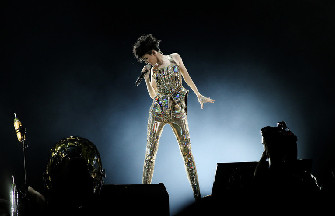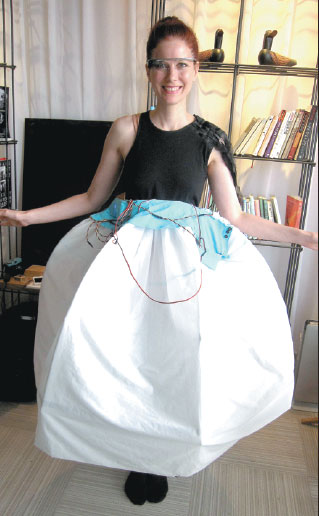Wired to Wear
Updated: 2014-09-16 09:10
By Tiffany Tan(China Daily USA)
|
|||||||||
'Mechanical' dresses are expected to become a part of everyday life in the near future. Tiffany Tan reports.
One day, fashionistas will be able to change their looks without having to actually change clothes. Or so Anina Trepte foresees at a time when lifestyles would have become much more hectic, sustainable and high-tech. The American model-turned-entrepreneur demonstrates her vision in a sleeveless dress that falls below the knees. One moment the blue-and-brown printed piece grazes her legs; the next, its skirt balloons around her.
"One dress for a woman will need to be multipurpose" because she won't be buying as many clothes and might not have time to change from one event to the next, Trepte says in an exclusive China Daily preview a week before the dress debuted in Beijing in August. "The question is how to create a dress that transforms radically."
The CEO of 360 Fashion Network, a fashion-technology company in Beijing, saw the answer in a robotic dress. In May, she began working on its blueprint with a wearable technology designer in Shanghai.
In 2006, British-Turkish Cypriot designer Hussein Chalayan launched in Paris "One Hundred Eleven", a collection that showcased a century of fashion in just five dresses. As models walked down the runway, their dresses morphed through three decades of style. Hemlines rose, sleeves unfurled, a zipper closed and a hat changed shapes, as if the audience was watching a movie time lapse.
Hidden under the dresses were battery packs, controlling chips and electronic motors. These operated pulleys attached to thin wires running throughout the garments, which pushed, pulled and moved the fabrics, explains Rob Edkins, director of British firm 2D3D that created the mechanism.
He describes the dresses as "mechanical". But they can also be considered robotic, since the garments use mechatronics, a combination of mechanical, electronic and software engineering that is used in robotics, says Sabine Seymour, director of the Fashionable Technology Lab at Parsons the New School for Design.
360Fashion's dress, unveiled at the Polish Embassy in Beijing in August, similarly employs a portable battery pack, small motors and a micro controller - but this time they're connected to bendable fiberglass rods. A preset timer, switched on or off with a button, initiates the skirt's up and down movements.
Polish designer Michal Starost, who Trepte approached to make the "outer dress", faced the challenge of concealing all the mechanical and electronic parts. Starost decided to make room for them along the waistline and to construct the dress with silk, since he needed a fabric that would be "very light and springy to avoid an umbrella effect".
Its creators now want the dress to become more "intelligent" and to move as a result of changes in its environment, rather than the push of a button.
"We can set it to, if it's bright, dark or there's somebody near you, the dress can drop its skirt," says Bruce Bateman, the American CEO of Bateman Research and a wearable tech designer in Shanghai, who designed the robotic dress' mechanism.
Trepte adds: "We even have an app developer, and the idea is that you can dial up how high you want your skirt to be."
Professionals working at the intersection of fashion and technology expect such products to become part of everyday life in the near future. They see a time when ordinary people will be wearing clothes that are 3-D printed, solar powered or can protect against pollution. They also talk about garments that can monitor a person's vital signs and fabrics that can change colors to reflect a person's mood.
And some are thinking about how to wash these clothes, with all their wiring, gadgets and fancy parts. They may be high-tech, but they're still going to get dirty and smelly.
Contact the writer at tiffany@chinadaily.com.cn

|
Anina Trepte models a robotic dress, which employs a portable battery pack, small motors and a micro controller. Photo By Zou Hong / China Daily |
(China Daily USA 09/16/2014 page10)

 Star Stefanie Sun holds concert in Beijing
Star Stefanie Sun holds concert in Beijing
 Faye Wong's manager refutes star's drug rumors
Faye Wong's manager refutes star's drug rumors
 Lu Yi and daughter Bei Er pose for street snaps
Lu Yi and daughter Bei Er pose for street snaps
 Photoshoots of actress Li Xiaomeng
Photoshoots of actress Li Xiaomeng
 Council of Fashion Designers of America Awards
Council of Fashion Designers of America Awards
 Fan Bingbing, first Chinese actress in Barbie Hall of Fame
Fan Bingbing, first Chinese actress in Barbie Hall of Fame
 Awarding ceremony of 2014 hito Pop Music held in Taipei
Awarding ceremony of 2014 hito Pop Music held in Taipei
 Zhao Liying's photo shoot for Children's Day
Zhao Liying's photo shoot for Children's Day
Most Viewed
Editor's Picks

|

|

|

|

|

|
Today's Top News
Improved quality 'key to growth', says Li
IMF assesses risks and benefits of shadow banking
Apple Pay eyes inroads to China
Sinopec privatization biggest in Xi's tenure
Beijing to tighten foreign hiring requirements
Hillary Clinton takes a big step toward 2016
US teachers visit China on fellowship
More CFAs buoy hopes for finance
US Weekly

|

|









